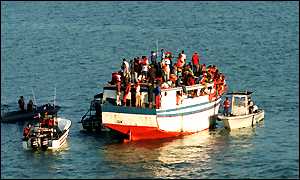Over the 19th century and the first half of the 20th century, most Haitians who went abroad did so to study. Many, if not all of them, went to France. However, in the United States, some Haitian books were also published during the 19th century. One of them was On the Equality of Human Races written by Anténor Firmin. Firmin presented a rebuttal to the "Essay on the Inequality of Human races" by Arthur Gobineau.
But, France didn't stand as the main destination for Haitian students in the second half of the 20th century. The USA became the primary destination for both students who intended to go back home and for those who decided to emigrate. The following pages present a time line of Haitian immigration.
Haitians come to the US and, to a lesser degree, France and other western European countries as legal immigrants,illegal immigrants,and as refugees.Members of the middle class started migrating during the US occupation of Haiti in the 1920's and 1930's.
Legal immigration tends to be difficult for Haitians,but ,because of desperate economic and political conditions in Haiti,the rate of Haitians going illegally to other countries remains high. Most illegal immigrants to the US. They leave Haiti by small boats,despite significant risk of drowning or interdiction at sea.The number of refugees, never very great, has declined since the early 1990's to several thousand year.Most immigrants and refugees are adults or teens (with few infants or old people),and most are poorly educated.

Haitians immigrants certainly constitute a very visible segment of temporary American society. (Where do most Haitians settle in the US?) This visibility is due too the fact that they have been steadily migrating in significant numbers to the United States since the late 1950's and early 1960's. This wave of immigration began soon after Francois Duvalier (papa Doc) became President of Haiti.The political repression that characterized the Duvalier period forced a large number to seek safety in the USA.The combination of push and pull factors led Haitians to cross the Caribbean sea, by plane or by boat legally or illegally in order to reach the shores of America, the land of opportunity, to begin a new lives.